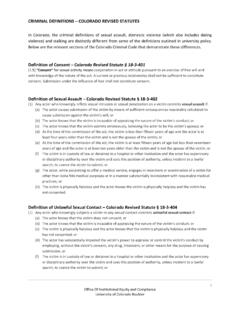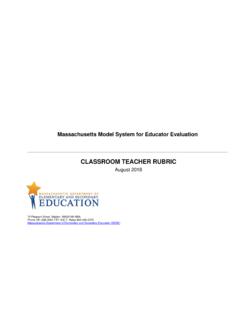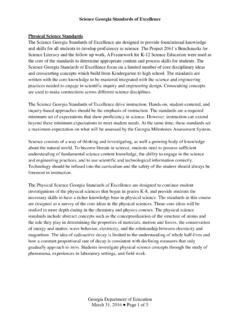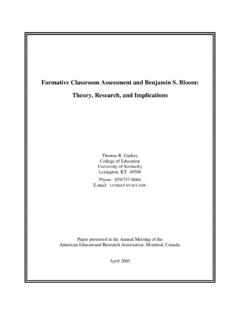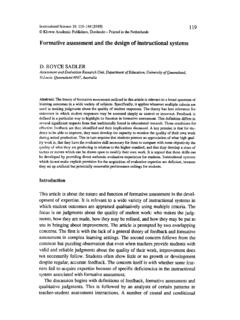Transcription of Classroom Assessment Principles to Support Teaching and ...
1 Classroom Assessment Principles to Support Teaching and LearningLorrie A. Shepard, Elena K. Diaz-Bilello, William R. PenuelFEBRUARY 2020 Scott F. MarionUniversity of Colorado BoulderCenter for Assessment2 AcknowledgementsAn initial draft of these Classroom Assessment Principles was developed in preparation for the NCME Special Conference on Classroom Assessment held at the University of Colorado Boulder, September 18-19, 2019. The authors wish to acknowledge extensive feedback and suggestions received from other conference organizers, partners, and participants, especially Derek Briggs, Sue Brookhart, Capucine Chapman, Erin Furtak, Margaret Heritage, Angela Landrum, Fritz Mosher, Rick Stiggins, and Doug CADREThe Center for Assessment , Design, Research and Evaluation (CADRE) is housed in the School of Education at the University of Colorado Boulder. The mission of CADRE is to produce generalizable knowledge that improves the ability to assess student learning and to evaluate programs and methods that may have an effect on this learning.
2 Projects undertaken by CADRE staff represent a collaboration with the ongoing activities in the School of Education, the University, and the broader national and international community of scholars and stakeholders involved in educational Assessment and CitationShepard, L. A., Diaz-Bilello, E., Penuel, W. R., & Marion, S. F. (2020). Classroom Assessment Principles to Support Teaching and learning. Boulder, CO: Center for Assessment , Design, Research and Evaluation, University of Colorado document presents a set of Classroom Assessment Principles intended as a resource for practitioners, especially school leaders and district and state policymakers. Together these Principles articulate a shared vision for effective Classroom Assessment practices . The key ideas guiding this vision come directly from learning sciences research and the research literatures on motivation and Assessment . They explain how Classroom Assessment can best be enacted to Support Teaching and learning.
3 To ensure that the document remains maximally readable and useful, the text is not interrupted by academic citations; references listed at the end provide the research evidence that supports these Assessment includes both formative Assessment practices focused on moving learning forward and summative Assessment used for grading, reporting, and competency determinations. The vision of Classroom Assessment advanced here is based on sociocultural learning theory, which holds that students cognitive and affective capabilities and ways of being are jointly developed through interaction in their social and cultural context. Importantly, sociocultural theory attends to student identity and sense of belonging as part of learning as well as to the cognitive processes that enhance academic achievement. The Assessment Principles that follow from this theory are closely connected to ideas about asset-based pedagogies and responsive Teaching . In contrast to deficit perspectives, asset-based approaches seek to engage the rich experiences that students bring with them to the Classroom by adapting instruction and responding to those language and cultural resources.
4 Our Assessment Principles address equity by fostering student agency and attending to identity and cultural practices from their communities. Although formal instruments and tests are a part of Assessment , especially for summative purposes, formative Assessment need not rely on formal instruments and is more often effective when embedded in ongoing instructional activity. The first set of Principles below outlines our vision, which is framed from the vantage point of Classroom teachers and their students. These Principles articulate the actions and commitments needed to create an equity-focused learning culture. While teachers (and students) are the primary Classroom actors, it is unlikely that individual teachers could make all of these fundamental changes on their own without Support from school and district leaders. Subsequently, we outline several supportive statements indicating what leaders based in schools, districts, and states can do with the collaboration of subject-matter experts, measurement experts, and teacher educators to Support a school s enactment of this should teachers and their students do to enact Assessment as part of an equity-focused learning culture?
5 Develop a shared understanding of valued learning goals are often contested and, even when goal statements seem to be agreed upon, there may not be a shared understanding about what success might look like or how to get there. Especially for the novice learner, understanding what the goal is and why it s important and having good models for what s expected are all essential conditions for productive learning. As noted by several conference participants, helping students understand the goals for learning is itself a challenging aspect of Teaching because, paradoxically, students cannot fully understand what they do not yet know. Providing access to the goals and purposes for learning, must be taken up in engaging ways, with age-appropriate language and examples, and requires more than posting learning objectives and standards. Integrate curriculum, instruction, and Assessment based on well-founded theories of development of curricular units of study, instructional activities, and Assessment questions, tasks, and observations should be envisioned together.
6 This integrated approach helps maximize the chances for Assessment and learning activities to be coherently connected, unlike far too many Assessment events that are separate from instructional activities. Such co-design requires a fine-grained, discipline-specific theory or model of learning. Models of learning 5include culminating goal statements, but importantly, they also model or describe various pathways reflecting students partial and emergent understandings enroute to more complete accomplishment of a goal. Learning progressions are one type of more formally developed model of learning, but more often models of what to do next can be supported by informal learning progressions or portfolios of student work collected over time to document both typical patterns and variations in how student thinking develops. Recognize and build on the knowledge and experiences that students bring from their homes and research taught us decades ago about the importance of building on prior knowledge for new learning, but this was often taken to mean using prior knowledge taught in school.
7 Today, sociocultural theory and asset-based pedagogies show us the importance of all life experiences as relevant to learning, including students funds of knowledge or the accumulated body of knowledge, assets and cultural ways of interacting drawn from their homes, communities, and influential social forces, as well as intuitive understandings of the natural world. Part of respecting student identity as fundamental to learning means inviting students to share experiences and perspectives from their funds of knowledge and drawing connections to learning goals. Connected to the second principle, this principle also calls for developing learning experiences and materials around students funds of knowledge to help scaffold their understanding and access to content. Importantly, this type of orientation moves away from a deficit paradigm to more affirming, asset-based conceptions that draw on student strengths and are informed by student experiences and backgrounds.
8 Ensure that authentic instructional and Assessment tasks are drawn from and connect to life outside of school to enhance both meaning and learning requires robust curricular activity systems to engage students with high-quality tasks closely matched to the kinds of thinking and doing envisioned by valued learning goals. Authentic, real-world tasks are especially important for initial learning because they help to give meaning and purpose to otherwise decontextualized school work. At the same time, authentic issues and problems connected to students lives help to ensure that school learning has relevance beyond the Classroom . This principle is closely connected to principle #3 about connecting to the experiences and strengths that students bring with them to school, but it also entails opening new doors and offering opportunities that help make new learning meainingful and genuine. The call for authenticity does not mean that all learning must be project-based, nor does it rule out checks for things like math facts and grammar rules.
9 The research evidence does show, however, that focusing Classroom activities on isolated drills on facts is ineffective and that knowledge gained through applied contexts is more likely to be engaging and result in deeper learning. 6 Engage in instructional practices where students talk with each other around meaningful tasks as a way to elicit and extend student thinking and to help students learn to listen and Support the development of each other s contrast to traditional Teaching approaches dominated by teacher talk, discourse-based instructional practices Support deep learning by involving students in talking aloud about their reasoning and making it a part of the Classroom culture to regularly learn from and critique the reasoning of others. The importance of helping students develop the ability to explain their reasoning and to Support an argument with evidence can be seen in today s standards for mathematics,science, English language arts, history, social studies, and other subject areas, where communication and argumentation skills are seen as fundamental to disciplinary expertise.
10 These interactive strategies help to develop students abilities to make meaning and internalize knowledge thus moving away from memorizing yet enhancing memory by deepening conceptual understanding. Such collaborative inquiry and talk-based instructional practices provide for feedback, self, and peer Assessment without the need for formal Assessment products. Value student ideas by presenting tasks in multiple modes and by using artifacts and other representations to document their thinking and addition to talk-based instructional practices that elicit and build on student thinking, presenting tasks in multiple modes can serve equity goals and affirm a positive learning culture. For example, when teachers ask English language learners to draw, speak, listen and write to communicate ideas, using multiple modes provides opportunities for these students to engage in productive language fluency and to work through ideas. Given that the point of formative Assessment is to advance learning while still in development, then working on and sharing partially formed ideas, in ways best connected to where students are, has to be a normal part of Classroom discussions and accessible and actionable information about how students and teachers can teachers, both formal and informal assessments are the most useful when they provide specific substantive insights about student thinking -- where student understandings are on firm ground as well as where they are stuck, and more importantly what alternative conceptions 7might be in the way of making progress.








